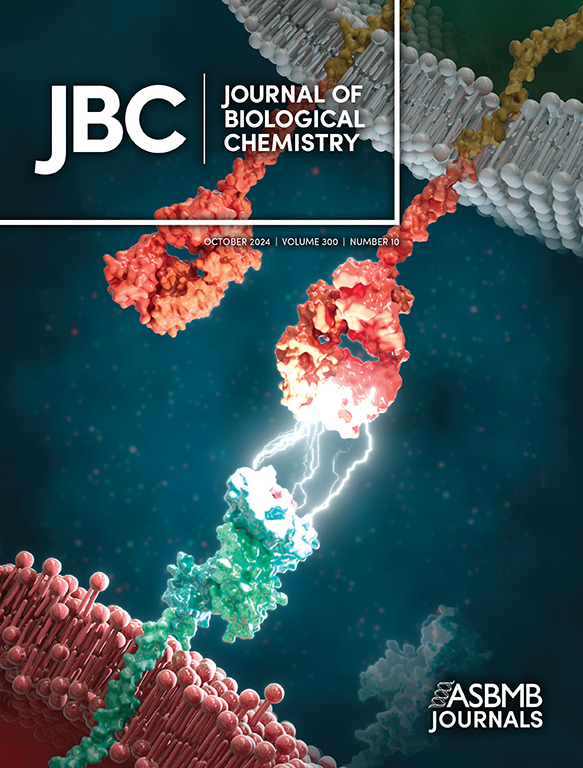多胺刺激起始因子eIF5A2的蛋白质合成,参与mRNA解码,与eIF5A1不同。
IF 4
2区 生物学
Q2 BIOCHEMISTRY & MOLECULAR BIOLOGY
引用次数: 0
摘要
多胺存在于所有生物体内,其稳态与人类健康和疾病密切相关。此外,它们是小的脂肪族阳离子,通过与酸性物质的相互作用表现出多功能活性,从而使我们无法理解它们在生物过程中的分子功能。eIF5A1和eIF5A2具有很高的氨基酸序列相似性,使用亚精胺的假设对它们的功能至关重要。eIF5A1在所有组织中普遍表达,对正常细胞生长至关重要,而eIF5A2通常在人类癌症组织中表达;然而,eIF5A1和eIF5A2之间的功能差异尚不清楚。在这里,我们发现eIF5A2在翻译水平上受到多胺的调节,并且eIF5A2而不是eIF5A1对癌细胞生长很重要。在5'-UTR上,miR-6514-5p负调控eIF5A2 mRNA的翻译起始,多胺抑制该miRNA功能,促进eIF5A2的合成。eIF5A1或eIF5A2沉默的细胞的蛋白质组学分析显示出不同的谱。此外,多胺上调了五种核糖体蛋白的表达,尤其是与癌症恶性相关的RPS27A、RPL36A和RPL22L1。我们的研究结果揭示了由多胺和miR-6514-5p调节的eIF5A2在癌细胞增殖中的重要作用,这表明eIF5A2与调节癌症进展的核糖体之间的相互作用是癌症治疗的选择性靶点。本文章由计算机程序翻译,如有差异,请以英文原文为准。
Polyamines stimulate the protein synthesis of the initiation factor eIF5A2 participating in mRNA decoding distinct from eIF5A1.
Polyamines are present in all living organisms, and their homeostasis is closely associated with human health and disease. Further, they are small aliphatic cations that exhibit multifunctional activities through interactions with acidic substances, thereby precluding our understanding of their molecular functions in biological processes. eIF5A1 and eIF5A2 share high amino acid sequence similarity, and hypusination, using spermidine, is essential for their functions. eIF5A1 is ubiquitously expressed in all tissues and is essential for normal cell growth, whereas eIF5A2 is often expressed in human cancer tissues; however, the functional differences between eIF5A1 and eIF5A2 remain unclear. Here, we found that eIF5A2 is regulated by polyamines at the translational level and that eIF5A2, rather than eIF5A1, is important for cancer cell growth. The translational initiation of eIF5A2 mRNA was negatively regulated by miR-6514-5p at the 5'-UTR, and polyamines inhibited this miRNA function, facilitating eIF5A2 synthesis. A proteomic analysis of cells with either eIF5A1 or eIF5A2 silenced showed distinct profiles. In addition, polyamines upregulated the expression of five ribosomal proteins, particularly RPS27A, RPL36A, and RPL22L1, which are associated with cancer malignancy. Our findings reveal an important role for eIF5A2, regulated by polyamines and miR-6514-5p, in cancer cell proliferation, suggesting that the interaction between eIF5A2 and ribosomes, which regulate cancer progression, is a selective target for cancer treatment.
求助全文
通过发布文献求助,成功后即可免费获取论文全文。
去求助
来源期刊

Journal of Biological Chemistry
Biochemistry, Genetics and Molecular Biology-Biochemistry
自引率
4.20%
发文量
1233
期刊介绍:
The Journal of Biological Chemistry welcomes high-quality science that seeks to elucidate the molecular and cellular basis of biological processes. Papers published in JBC can therefore fall under the umbrellas of not only biological chemistry, chemical biology, or biochemistry, but also allied disciplines such as biophysics, systems biology, RNA biology, immunology, microbiology, neurobiology, epigenetics, computational biology, ’omics, and many more. The outcome of our focus on papers that contribute novel and important mechanistic insights, rather than on a particular topic area, is that JBC is truly a melting pot for scientists across disciplines. In addition, JBC welcomes papers that describe methods that will help scientists push their biochemical inquiries forward and resources that will be of use to the research community.
 求助内容:
求助内容: 应助结果提醒方式:
应助结果提醒方式:


